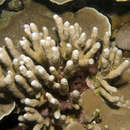Biology
provided by World Register of Marine Species
zooxanthellate
van der Land, J. (ed). (2008). UNESCO-IOC Register of Marine Organisms (URMO).
- license
- cc-by-4.0
- copyright
- WoRMS Editorial Board
Description
provided by World Register of Marine Species
Colonies may reach several metres across. They consist of mixtures of small plates and twisted projections, some projections developing into short, stout branches. The surface of the coral is covered with ridges which run between rows of calices. Calices themselves are minute (less than 1 mm diameter). Colours are usually basically brown or pale brown, but yellow colonies are also common, with strong pink colours also sometimes seen, some with blue edges to branches are plates (Sheppard, 1998). Colonies are laminar or contorted anastomosing branches and columns. Corallites are very small. They are separated into groups by ridges which characteristically converge towards each other forming flame-shaped patterns. Colour: pale cream or yellow, or dark bluish-brown, often with pale branch tips. Abundance: usually uncommon but occurs in a wide range of habitats (Veron, 1986). Distinguished by its extremely small calices (
Roux, J.P. (2001) Conspectus of Southern African Pteridophyta. Southern African Botanical Diversity Network Report 13 Page 118 (Includes a picture).
- license
- cc-by-4.0
- copyright
- WoRMS Editorial Board

